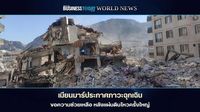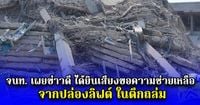On March 28, 2025, a devastating earthquake with a magnitude of 7.7 struck central Myanmar, causing widespread destruction and prompting the military government to declare a state of emergency in six affected regions. The earthquake's epicenter was located approximately 18 kilometers from the city of Sakae, and its tremors were felt not only across Myanmar but also in northern and central Thailand, parts of India, and even as far as Vietnam and Malaysia.
Eyewitness reports indicated that the quake occurred at around 12:50 PM local time, leading to chaotic scenes as buildings shook and residents fled to safety. In Myanmar, the military government, led by General Min Aung Hlaing, has urgently requested international humanitarian assistance. "We need the international community to provide humanitarian aid as soon as possible," stated government spokesperson So Min Tun during a visit to a hospital in Naypyidaw, where many injured individuals were being treated.
Despite the lack of official casualty figures, the government's plea for help suggests that the number of injured or deceased may be significant. The military government has declared a state of emergency in the hardest-hit areas, including Sakae, Mandalay, and the eastern Shan State. Reports from the region indicate severe damage to infrastructure, including collapsed buildings and a bridge over the Irrawaddy River.
In a related development, Myanmar's Minister of Interior expressed concern over the need for assistance to various ethnic groups affected by the disaster. The Ministry of Natural Resources and Environment has also emphasized the importance of providing help to those impacted by natural disasters, coordinating efforts with the Office of Natural Resources and Environmental Policy and Planning (ONEP). According to ONEP, approximately 7.7 million acres were affected by the earthquake, highlighting the extensive damage.
As the situation unfolded, the National Disaster Prevention and Mitigation Command in Thailand held an emergency meeting to assess the impact of the earthquake. Bangkok Governor Phasakorn Bunyalak reported that buildings in the Chatuchak area collapsed, leaving many people stranded. The emergency response teams, including the Urban Search and Rescue (USAR) team, were deployed to assist in rescue operations. "Helping those trapped in buildings is our top priority," he stated.
Emergency services in Bangkok have established a staging area in Pathum Thani Province to coordinate relief efforts. By 3:55 PM, equipment such as ambulances and rescue vehicles had been dispatched to assist those affected in the Chatuchak area. The governor urged citizens to remain updated on the situation and to contact emergency services if they required assistance.
The earthquake's tremors were also felt in Vietnam, where hundreds of residents evacuated from high-rise buildings in Hanoi. Reports from Malaysia indicated that residents in Penang experienced similar sensations, leading to widespread panic. In India, tremors were felt in Kolkata and parts of Manipur, but no significant damage was reported.
As rescue operations continue, images shared on social media depict the aftermath of the earthquake in Mandalay, where a two-story residential building partially collapsed. The local Red Cross has raised concerns about the impact on public infrastructure, such as roads and bridges, and the potential risk to large dams in the area.
In the wake of this disaster, the Thai government has emphasized the importance of being prepared for emergencies. Citizens are encouraged to save emergency hotline numbers, including those for police, fire services, and medical emergencies, to ensure quick access to assistance. The Department of Disaster Prevention and Mitigation has highlighted the need for public awareness regarding disaster warnings to facilitate rapid response.
Prime Minister Narendra Modi of India expressed solidarity with the affected nations, stating, "India stands ready to provide assistance to Myanmar and Thailand during this difficult time." His message was shared on social media, emphasizing India's commitment to helping those in need.
As the international community rallies to support the affected regions, the full extent of the damage remains unclear. However, early reports suggest that the number of casualties could rise significantly as rescue teams continue their work. The situation is fluid, and officials are urging citizens to remain vigilant and prepared for aftershocks, which could exacerbate the already dire circumstances.
In conclusion, the earthquake that hit Myanmar and surrounding regions serves as a stark reminder of the vulnerability of communities to natural disasters. As rescue operations unfold and assistance is mobilized, the focus remains on the urgent need to support those affected and to restore stability in the wake of this catastrophe.









